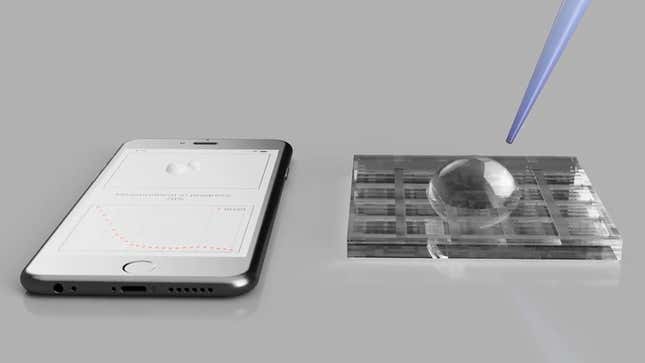
We take for granted that the water coming out of the kitchen faucet is safe to drink, but that’s not always the case in other parts of the world. So researchers at the University of Cambridge are developing a new approach to testing for contaminants using a device that billions of people already use every day.
Modern capacitive touchscreens (the kind that can easily detect the subtlest finger taps instead of requiring users to press hard on the screen) feature an invisible grid of electrodes that carry a very small electrical charge. When your conductive finger touches the screen it changes the charge level at a specific location that the smartphone can detect based on grid coordinates. That’s a grossly simplified crash course on how the technology powering modern touchscreens work, but what’s important is their use of a changing electrical charge.
In a recently published paper, the University of Cambridge researchers explain how a stripped-down touchscreen—the same hardware used in smartphones and tablets—was found to be able to detect the electrically charged ions in an electrolyte. Different liquids were piped onto the surface of the touchscreen and using the standard software that’s used to test these screens, the researchers were able to differentiate the samples based on how “the fluids all interact with the screen’s electric fields differently depending on the concentration of ions and their charge.”
The touchscreens used in mobile devices are tuned and calibrated to best respond to interactions with fingers, but the researchers believe that by altering the design of the electrodes, even in just a small area of the screen (a custom app could indicate exactly where a sample needs to be placed) the sensitivity could be optimized for detecting contaminants in samples like soil and water.
Being able to detect ions using touchscreens in consumer devices means that serious issues stemming from arsenic contamination in drinking water could be more easily avoided without the need for additional testing equipment. Arsenic is considered a Group-A carcinogen linked to bladder, kidney, liver, lung, and even skin cancers, and while it’s filtered out of most municipal water systems, it still poses a serious risk in parts of the world without water treatment plants. It can be detected using simple color-changing test strips, but they can be expensive, so finding a way to leverage existing devices for such testing is a more practical approach to the problem.
Eventually, the researchers hope to find ways to further upgrade the sensitivity of touchscreen technology so it could detect a wide range of molecules, including heavy metals like lead, another problematic contaminant in water affecting millions around the world. It would require companies making smart mobile devices to be willing to spend the extra money to improve the capabilities of the touchscreens they utilize, but given companies like Apple have in recent years been focusing on the health benefits of its devices, it might not actually be that hard of a sell.